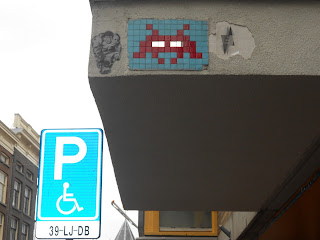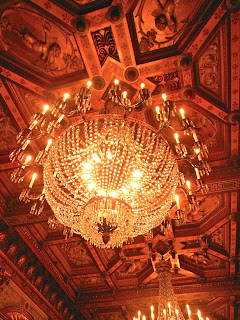last week was core course week at dis. this is a week spent on immersion in your core course (mine, for example, is human health and disease) - furthering exploration of topics related to medical practice and policy.

the week consisted of a three day short study tour to århus and vejle, two days in copenhagen, and no elective classes. objectives for the week included: showcasing examples of clinical practice and health care systems in different sectors as well as broadening our view of the challenges that health care providers face; showing examples of research with clinical relevance; exploring and learning more about denmark through exposure to the culture, history and socioeconomic climate of the region; engaging in a personal learning process outside the classroom by actively participating and challenging current ideas and assumptions; getting to know some of the "hot issues" regarding health care in denmark; and geting to know fellow students and professors in an educational and social setting outside dis.
and no elective classes.
on monday, we left copenhagen and headed toward århus located in denmark's jutland. our first visit was a meeting with a general practitioner at skødstrup lægepraksis to gain a better understanding of the danish health care system. the consultation rooms in the clinic were probably the nicest consultation rooms i had ever seen. white walls, high ceilings, and tasteful sculpture and artwork including calder-inspired mobiles gave the room a light, airy, healthy, and welcoming feel.
the danish health care system is deeply intertwined with the danish welfare state system, a cradle-to-grave social welfare system where all citizens are guaranteed certain fundamental rights based on national agreed standards largely financed by public funds through general taxation. dr. kallestrup, the general practitioner, for example, pays 76% in taxes. however, with this taxation system, all danish citizens gain a number of free services.
the gp's are the gatekeepers of the danish health care system and, therefore, encounter 88% of all patients and for every 10 patients, the gp will only refer 1 onto a specialist. dr. kallestrup had one of the best dispositions i had ever seen in a doctor, and he noted how happy he and his colleagues are with their work. sounds kind of like a utopia, no?
on tuesday, we visited skejby hospital (also in århus) and learned about various research being conducted there including experimental heart valve research, cardiovascular mri research and research on stem cells for interventional diagnostics and therapy. many of these experiments require work to be done on animals, and we got the experience of observing pigs undergoing open heart surgery and other tests, as if they were any normal human beings!
 |
| sofia, hannah and i in front of harald bluetooth's commemorating stone |
the trip to the hospital was followed by a visit to jelling, the home of the jelling stones. these are massive carved runestones from the 10th century. the older of the two stones was raised by king gorm the old in memory of his wife, thyra. the larger of the two stones was raised by king gorm's son, harald bluetooth (yes, the bluetooth phone device is named after this king who united dissonant danish tribes into a single kingdom) in memory of his parents, celebrating his conquest of denmark and norway, and his conversion of the danes to christianity.
 |
| ancient burial mound |
 |
the older of the two stones. considered denmark's
baptismal certificate as it features one of the
earliest records of the name "danmark" |
the trip was followed by a visit to an indoor go-karting track. while the adrenaline kicked in and a need for speed took over my body for 15 minutes worth of winding laps around the track, i don't think anyone should worry of this rush becoming an addiction anytime soon.
finally, on wednesday we visited the århus pet center and cfin (center of functionally integrative neuroscience) at the århus university hospital. again, we got a tour of some of the facilities, a peek into their research work, and this time saw an anesthetized pig receiving an mri scan.
after a yummy lunch in the city center, we went on a guided tour of the ARoS museum of modern art. it's a fantastic building with some incredible works of art including "the 9 spaces," a so-called 'gallery in progress' of installation art, where 1 or 2 rooms are done each year. referring to dante's "the divine comedy", the whole museum in transformed as part of the travel from hell to heaven.
 |
| us "girls" sittin with ron mueck's "boy" |
 |
| more "omgivelser" |
 |
| in ólafur elíasson's installation, "omgivelser" |
 |
| some good ol' gilbert and george |
edvard munch - angst and anxiety was a fantastic exhibition also on display while we were there. it is an exhibition that aims to show how the concept of anxiety has been a driving force throughout the norweigan artist's art and life: anxiety over life, anxiety over love and anxiety over death.


 |
| an installation on the museum roof entitled "your rainbow panorama" by ólafur elíasson |
we bid adieu to western denmark, and four hours later found ourselves back in the hustle and bustle of copenhagen. the next day was dedicated to a workshop that had us reflect on the tour as well as a lecture on the medical history of copenhagen.
friday might have proved the most eye opening part of the week. each student signed up for a different workshop, gaining insight into a different aspect of danish health - mine focused on disease prevention in copenhagen. while i learned little about disease prevention, i did get a glimpse of disease treatment in the city. after a long and dull powerpoint containing a number of useless graphs, charts, statistics, and all the bullshit they deliver, we took a 15 minute walk to nørrebro to visit a drug consumption building. near the meatpacking district, the red light district, amidst chic caffes, artsy theater houses, and ornate buildings, is a center for drug addicts. the building provides the people with a safe space for their drug use, giving them unlimited access to the building, sterile needles and other equipment, and meals - all free thanks to the danish citizens' taxes.
the mentality is that people who visit this house will develop a healthy relationship with the nurses and workers there, and in the process realize that they would like to turn away from this way of living. over time, they will come to the nurses to ask for help (no one who works there, however, is allowed to offer help or treatment) and eventually receive the care they need. however, when 200-300 individuals are making their way to this building every day, and approximately 10% of the people go on to receive further treatment, the need for prevention seems all the more necessary. it is my own opinion if this way of treating individuals with drug addictions is successful, and irrelevant to state here, but the real issue i have is with the preventative measures the danish health care system is providing, or not providing, its people.
when the government is giving its citizens a mountain of benefits, taking away half to three-quarters of their salary, and the people have little need to save their money or think about how their actions will impact their future, i believe that this plays into the mentality of living a certain lifestyle in the present without regard for the future.
when a small 10-year old compact car in denmark costs the equivalent of a ferrari in the states, and housing and groceries are anything but cheap, and an emphasis on having a social life is stressed with a city that provides hundreds of clubs, bars, and the danes are known for being some of the heaviest drinkers in europe, a certain type of frivolous lifestyle seems to be at play. a country that prides itself on being the happiest country in the world, yet has 200-300 people, in a city of 1.2 million, visting a consumption clinic for drugs and a meal with no worry of any immediate sanctions, doesn't quite align. yes, the people receive free healthcare, and maintain an honest and trusting relationship with their gp. but when only one in ten patients can be referred to a specialist, and specialists only make up 12% of the healthcare system, i wonder if people are getting the treatment they need and want and deserve.
apart from prevention i question the future of the health care system in general. the large immigrant population brings with it a whole new can of worms. the danes pride themselves (loudly) for their homogeneity, a keystone for why their system works, as well as a culture of trust. the immigrant population seems to threaten all of this.
with all this in mind, i'm not saying that in comparison, the health care system in the united states is perfect and without flaws. it most certainly has that and much more. however, having heard the "greatness" that is the health care and welfare system of danish society, and how much we have to learn from the danes, there are some aspects that, at least to me, do not seem too adaptive, progressive, or healthy.
we have been learning what great innovators and designers the danes are. in history, they have proved that when struggles and the need for innovation arises, they create, compromise, and conquer. in my view, their system cannot stay afloat for long in the massive globalization that is occurring. while it is certainly not failing, i see it struggling in the near future and am curious as to why more people do not seem to be concerned with this prospect. i suppose i trust the danes, but i am curious how they will deal with these issues as the world turns and they turn with it.
























.jpg)





